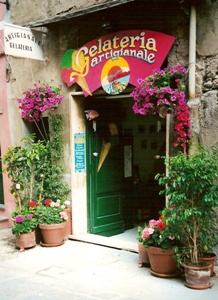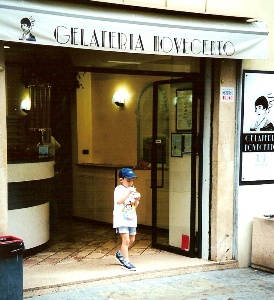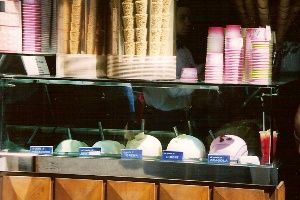Special Feature: Products Sally Recommends
Gelato: Italy's Quintessential Outdoor Treat!
 When in Rome, roam with a gelato. The Italian ice cream is, according to Faith Heller Willinger, "...the only food that Italians will eat on the street." Willinger's Eating in Italy: A Traveler's Guide to the Gastronomic Pleasures of Northern Italy points out some prime gelato stops, along with plenty of other culinary adventures.
When in Rome, roam with a gelato. The Italian ice cream is, according to Faith Heller Willinger, "...the only food that Italians will eat on the street." Willinger's Eating in Italy: A Traveler's Guide to the Gastronomic Pleasures of Northern Italy points out some prime gelato stops, along with plenty of other culinary adventures.
There's no better way to while away an afternoon than by strolling the byways of a quaint Italian village licking a gelato al cioccolato from a cone (that's cono in Italian). Worried about that soft, melting treat dripping down your new silk blouse? Order a coppa instead. You'll not only get a choice of cup sizes, but also an adorable plastic paddle to spoon it up with. Samples of cup sizes are usually pasted to the wall, the price for each scrawled on the bottom. Most gelaterie will allow you two or three flavors, even in the smallest size. It's a good way to sample. Larger sizes allow for even more diverse sampling; although requesting too many in a single cup may be considered bad form.
The surprising news is that gelato is good for you—relative to ice cream, anyway. While ice cream typically is made with cream and egg yolks, most gelato is made from milk. Depending on the region it is often made without eggs. That leaves gelato with less fat and cholesterol. Fruit gelato generally has no fat added.
Despite the lower fat count, gelato tastes sinfully rich and delicious. Less air is incorporated during the freezing process, and it is frozen to a temperature not quite so frigid as ice cream. The result is a dense, creamy, velvety-smooth, flavor-packed lick that melts instantly on the tongue and avoids that nasty ice cream headache.
Less fat coating the tongue means you taste more flavor. Italians love their gelato flavors which, in addition to vaniglia and cioccolato, include the likes of stracciatella (chocolate chip), "After Eight" (named for the chocolate-covered mint), caffé (coffee), moka (mocha), crema di riso (bits of rice, like rice pudding), panna cotta (the popular Italian dessert of cooked cream), pistacchio (pistachio), castagna (chestnut), noce (walnut) and zuppa inglese (English trifle).
 Fruit-flavored gelato is made from fresh fruit and sugar, more in the style of sorbet than ice cream. Fruit flavors reflect the changing seasons. Depending on the time of year, you might find albicocca (apricot), amarena (sour cherry), ciliegia (cherry), frutti di bosco (literally fruits of the woods, meaning mixed wild berries), mandarino (tangerine), mirtillo (blueberry), pera (pear), pescanoce (nectarine), pompelmo rosso (pink grapefruit) and tarocchio (blood orange).
Fruit-flavored gelato is made from fresh fruit and sugar, more in the style of sorbet than ice cream. Fruit flavors reflect the changing seasons. Depending on the time of year, you might find albicocca (apricot), amarena (sour cherry), ciliegia (cherry), frutti di bosco (literally fruits of the woods, meaning mixed wild berries), mandarino (tangerine), mirtillo (blueberry), pera (pear), pescanoce (nectarine), pompelmo rosso (pink grapefruit) and tarocchio (blood orange).
Some shops boast as many as three lemon flavors: limone, limoncino, and limoncello. The clerk in a gelateria in the famous resort town of Bellagio on Lake Como explained that limone is made from the juice of the lemon, while limoncino uses the rind. Limoncello is made with the Italian liqueur of the same name, which is typically stored in the freezer and served in an iced glass. All three have the refreshing sweet-sour appeal of lemon ice.
 To be certain your gelato is made in-house, look for signs saying Produzione Propria or Artigianale. If you don't see a sign, ask. One give-away is the tubs of gelato usually visible in the window: if they are made of white plastic you can bet the gelato is from a factory. House-made gelato is almost always packed in stainless steel tubs as they can be sterilized for reuse. It's worth asking if you don't see a sign—not all gelato sold from the metal tubs is made in house.
To be certain your gelato is made in-house, look for signs saying Produzione Propria or Artigianale. If you don't see a sign, ask. One give-away is the tubs of gelato usually visible in the window: if they are made of white plastic you can bet the gelato is from a factory. House-made gelato is almost always packed in stainless steel tubs as they can be sterilized for reuse. It's worth asking if you don't see a sign—not all gelato sold from the metal tubs is made in house.
Once you've selected your flavors, step out into the street and do as the Italians do—mangia!
If you want to try your hand at making gelato at home, pick up a copy of Pamela Sheldon Johns' Gelato! Italian Ice Cream, Sorbetti, and Granite (Ten Speed Press 2000). The book includes plenty of information about gelato and other Italian frozen desserts, along with recipes. For more recipes, David Liebovitz’ Perfect Scoop: Ice Creams, Sorbets, Granitas, and Sweet Accompaniments (Ten Speed Press 2007) includes a small selection of gelati along with sorbets and granitas.
![]()
Note: This information was accurate when it was published. Please be sure to confirm all rates and details directly with the businesses in question before making your plans.



